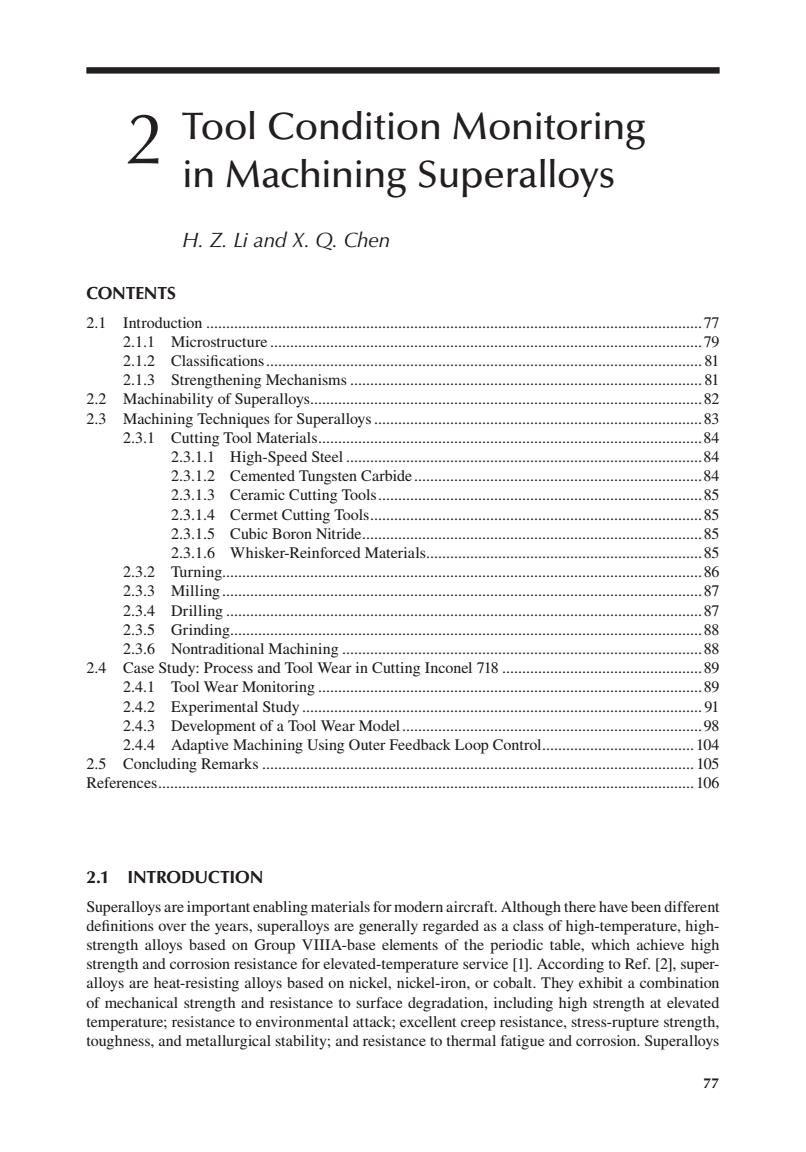正在加载图片...

2 Tool Condition Monitoring in Machining Superalloys H.Z.Li and X.Q.Chen CONTENTS 2.1 Introduction97 2.1.1 Microstructure… .79 2.1.2 Classifications. 81 2.13 Strengthening Mechanisms..... 8 2.2 Machinability of Superalloys...... .82 2.3 Machining Techniques for Superalloys............................ .83 2.3.1 Cutting Tool Materials. .84 2.3.1.1 High-Speed Steel........... .84 2.3.1.2 Cemented Tungsten Carbide.84 2.3.1.3 Ceramic Cutting Tools............. .85 2.3.14 Cermet Cutting Tools..85 2.3.1.5 Cubic Boron Nitride.............. 85 2.3.1.6 Whisker-Reinforced Materials. .85 2.3.2 Turning… .86 2.3.3 Milling .87 2.3.4 Drilling… 87 2.3.5 Grinding. .88 2.3.6 Nontraditional Machining........... .88 2.4 Case Study:Process and Tool Wear in Cutting Inconel 718............................................89 2.4.1 Tool Wear Monitoring.............. 89 2.4.2 Experimental Study................ .91 2.4.3 Development of a Tool Wear Model...... .98 2.4.4 Adaptive Machining Using Outer Feedback Loop Control..........104 2.1 INTRODUCTION Superalloys are important enabling materials for modern aircraft.Although there have been different definitions over the years,superalloys are generally regarded as a class of high-temperature,high- strength alloys based on Group VIIIA-base elements of the periodic table,which achieve high strength and corrosion resistance for elevated-temperature service [1].According to Ref.[2].super- alloys are heat-resisting alloys based on nickel,nickel-iron,or cobalt.They exhibit a combination of mechanical strength and resistance to surface degradation,including high strength at elevated temperature;resistance to environmental attack;excellent creep resistance,stress-rupture strength, toughness,and metallurgical stability;and resistance to thermal fatigue and corrosion.Superalloys 7777 Tool Condition Monitoring in Machining Superalloys H. Z. Li and X. Q. Chen 2.1 INTRODUCTION Superalloys are important enabling materials for modern aircraft. Although there have been different definitions over the years, superalloys are generally regarded as a class of high-temperature, highstrength alloys based on Group VIIIA-base elements of the periodic table, which achieve high strength and corrosion resistance for elevated-temperature service [1]. According to Ref. [2], superalloys are heat-resisting alloys based on nickel, nickel-iron, or cobalt. They exhibit a combination of mechanical strength and resistance to surface degradation, including high strength at elevated temperature; resistance to environmental attack; excellent creep resistance, stress-rupture strength, toughness, and metallurgical stability; and resistance to thermal fatigue and corrosion. Superalloys 2 CONTENTS 2.1 Introduction ............................................................................................................................77 2.1.1 Microstructure ............................................................................................................79 2.1.2 Classifications............................................................................................................. 81 2.1.3 Strengthening Mechanisms ........................................................................................ 81 2.2 Machinability of Superalloys..................................................................................................82 2.3 Machining Techniques for Superalloys..................................................................................83 2.3.1 Cutting Tool Materials................................................................................................84 2.3.1.1 High-Speed Steel .........................................................................................84 2.3.1.2 Cemented Tungsten Carbide ........................................................................84 2.3.1.3 Ceramic Cutting Tools.................................................................................85 2.3.1.4 Cermet Cutting Tools...................................................................................85 2.3.1.5 Cubic Boron Nitride.....................................................................................85 2.3.1.6 Whisker-Reinforced Materials.....................................................................85 2.3.2 Turning........................................................................................................................86 2.3.3 Milling ........................................................................................................................87 2.3.4 Drilling .......................................................................................................................87 2.3.5 Grinding......................................................................................................................88 2.3.6 Nontraditional Machining ..........................................................................................88 2.4 Case Study: Process and Tool Wear in Cutting Inconel 718 ..................................................89 2.4.1 Tool Wear Monitoring ................................................................................................89 2.4.2 Experimental Study .................................................................................................... 91 2.4.3 Development of a Tool Wear Model...........................................................................98 2.4.4 Adaptive Machining Using Outer Feedback Loop Control...................................... 104 2.5 Concluding Remarks ............................................................................................................ 105 References...................................................................................................................................... 106